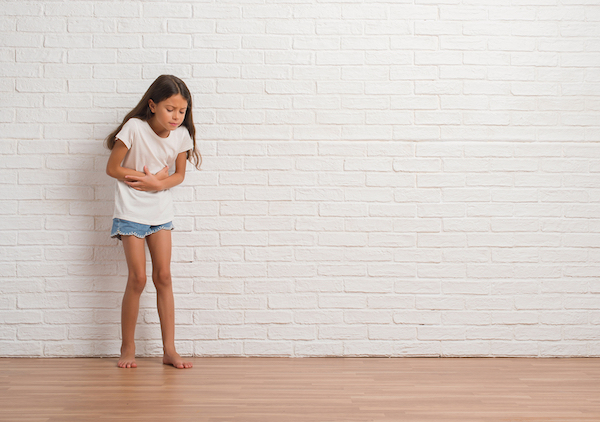How many times as a parent have you heard the words, “My tummy hurts”?
A stomach ache is probably one of the more common complaints kids have, said Dr. Tara Pedigo, a pediatrician at Augusta University Health’s Grovetown practice site.
But when is a tummy ache just that—and when is it more than what it seems?
The Big C
“In general, abdominal pain can be complicated, depending on how old your child is and what’s going on,” Pedigo said. “But in kids between ages two and 10, nine times out of 10, if they have belly pain, it’s related to constipation.”
In fact, your child can have chronic constipation even if he or she poops every day or has what’s called “breakthrough diarrhea” sometimes.
Essentially, constipation can happen if there’s not enough water and fiber (i.e. fruit and veggies) in your child’s diet. It can also happen because kids aren’t pooping when their body says it’s time—whether it’s because they’re potty training and are afraid of it hurting, or because they don’t want to go at school or out in public. The colon starts to stretch to hold the extra poop, then the signals that tell your child it’s time to go don’t work as well.
With constipation, kids will typically have intermittent belly pain about a half-hour after they eat. It might last about five to 10 minutes, then they’re playing again.
“So nine times out of 10, if your child comes up to you and says their belly hurts, in all honesty, the next thing I would say is, ‘Go try to poop,’” Pedigo said. “Usually, they feel better.”
Then, start with dietary changes. Add in more fresh fruits and vegetables, which are filled with fiber to get the bowel moving, along with probiotics (yogurt is a good source) and plenty of water or juice. If kids have been constipated for a while, be patient: It could take three to six months for their colons to shrink back and for signals to readjust. For others, it could be as short as two weeks. “Just be consistent,” said Pedigo.
When Is a Stomachache a Bigger Problem?
So what about that one out of 10, when your child’s tummy troubles are part of a bigger issue?
Pedigo says parents should be on the watch for kids who have some or all of these symptoms: abdominal pain, fever, blood in the stool and/or vomiting. “All of these things should make you go ‘Hmmmm,’” she said. “In some cases, it might warrant a visit to the doctor. In others, it could be an emergency.”
Anytime your child has significant abdominal pain, it could warrant a trip to the ER. The main fear, naturally, is appendicitis, which usually presents as sharp pain in the lower right part of the abdomen. With appendicitis, children will often refuse even their favorite meals and will be in so much pain that they can’t stretch out or lay flat on their backs.
Other, more unusual causes of severe belly pain include a volvulus or intestinal malformation, which is when your child’s bowel suddenly twists in on itself. “It’s like making a balloon animal, when you take the balloon and twist it on itself. That’s basically what happens. It can slip and pop right out, or it can slip and stay and cut off the blood supply,” said Pedigo.
A similar problem is called intussusception, which is when the intestine suddenly telescopes onto itself. Both, while rare, cause horrible pain, vomiting, and chunky or jelly-like red stools, and need to be repaired as soon as possible with surgery.
Then there’s diarrhea, usually related to bacteria or other causes in food that hasn’t been prepared properly or water that’s contaminated. Fever and blood in the stool can also be symptoms. We’ve all heard of salmonella, but other bacteria that could cause this include shigella and campylobacter, along with a parasite, giardia, that kids can pick up while camping due to infected water.
It’s not something anyone wants to do, but Pedigo says that if your child is having chronic diarrhea—not just diarrhea for one or two days, but multiple diarrhea stools over several days, along with other symptoms—it’s a good idea for parents to scoop up a sample of the stool, place it in a Tupperware in the fridge, and bring it to the doctor to test for bacteria or other causes.
And, anytime your child has chronic belly pain, it’s also a good idea to make notes on what your child is eating and when he or she is experiencing pain to see if you can identify a pattern. “Does it only happen when they’re in a situation where they’re nervous, or only after they eat? Is it on the weekends or are they waking up in the middle of the night with pain?” Pedigo said.
It’s Complicated
As Pedigo says, abdominal pain can be complicated—and that’s especially true as children get older. Then, pain can be related to a wider range of conditions, such as urinary tract infections, pelvic inflammatory disease, ovarian cysts, depression and anxiety, gastric reflux, ulcers and much more. “So for parents, I keep it simple: Look at how bad is the pain, does it come and go, is it associated with fever, is it associated with blood?” Pedigo said. “Go from there to determine if you need to take a wait-and-see approach, if your child needs a doctor’s visit, or if pain or symptoms are severe enough to head straight to the ER. And if you’re ever unsure, always start with a call to your pediatrician.”




